The cryptocurrency and blockchain warriors of Zagreb came together for the Zagreb Blockchain Development Conference at HUB385 on September 25, 2017. Among them, this old correspondent from a previous generation – it was an inspiring evening.
About thirty years ago, I was invited to an event at Haydock Park racecourse near Liverpool. I wasn’t told what the nature of the event was, except that it would change my life and make me rich, and so – with nothing better to do as an 18 year-old – off I went with the friend who was keen for me to experience this revelation.
It turned out that it was a presentation (and recruitment drive) for the multi-level marketing company called Amway, which specialises in health, beauty and home care products. What stays with me from that evening, apart from the fantastic promises of wealth, was the devotion of the crowd, the majority of whom were already Amway resellers but had come to learn from more successful sellers giving the speeches. There was a hit of religious fervour, almost cultism, in the proceedings. My Amway millions remain unmade.
I hadn’t thought about the night for a quarter of a century, and yet it came back to me on Monday, as I sat in a room full of hundreds of Croatian techie geeks, all of whom where a clear 15 years younger than I, with many of them hanging on every word of the presenters at the evening event, the Zagreb Blockchain Developers Meetup.
The blockchain. Have you heard of it? It is the future, apparently. Most people my age have no idea what it is, if they have heard of it at all, and yet its supporters claim it will change the world.
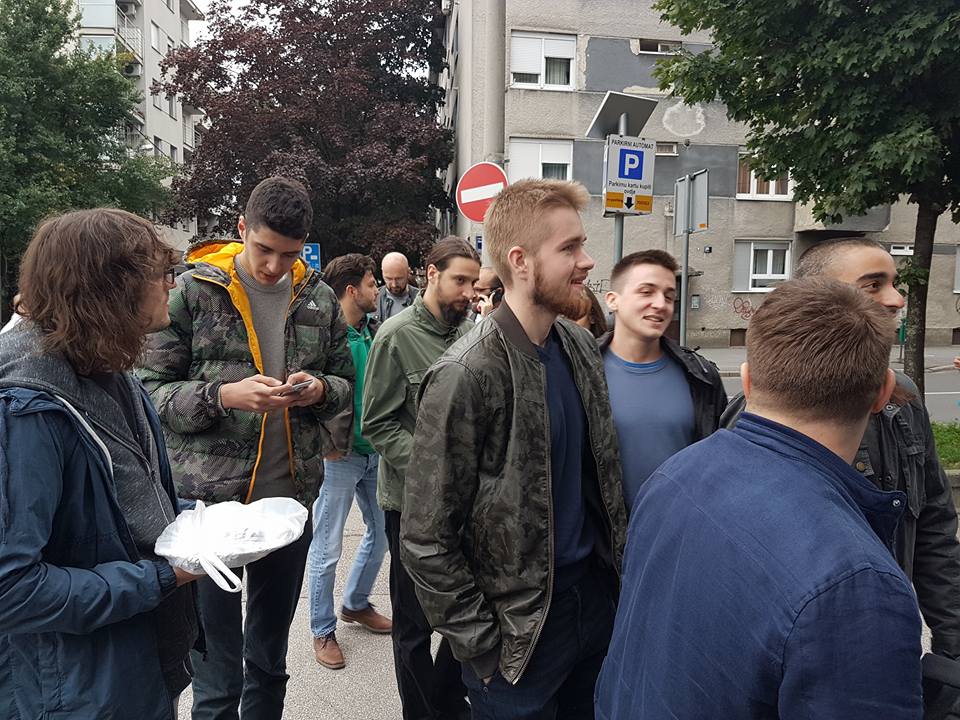
So what is the blockchain? A quick Google search: A blockchain is a decentralized and distributed digital ledger that is used to record transactions across many computers so that the record cannot be altered retroactively without the alteration of all subsequent blocks and the collusion of the network. That to me sounded a little too technical and remote for me to pay much interest. The opening paragraph of the event invitation gave a little more light:
“Blockchain technology is set to radically change the world we live in. Instant global payments, secure escrow, trust systems and prediction markets are all just small pieces of what can be done. By utilizing the trustless open ledger, any kind of distributed activity can be made more efficient and secure.”
My (much younger and much more successful) business partner, who had invited me to the event, had sent me some YouTube videos so that I could get partially up to speed before the conference, and it was here that my eyes were truly opened, and I found myself panicking that technology was going to overtake my simple world order at an even quicker rate than I had imagined. One example will suffice:
According to one of the TED Talks on the subject, last year more than $600 billion was sent in remittances from immigrant workers back to family in their origin countries via Western Union. Western Union is a convenient and often unique service for transferring money in some parts of the world, but it is expensive at 10% commission, meaning that the middleman took a staggering $60 billion in commission, from the Filipino maids in Toronto sending back $300 a month to their parents in Manila, who then have to travel to the nearest Western Unio office to get their cash. Using a system powered by one of the blockchain’s cryptocurrencies, Bitcoin, those maids now have a much faster – and much cheaper – service. They simply have to pick up their phone (no more walking to the Western Union office), send their $300 through the system. Mum gets a notification in Manila that she has cash seconds later. And then, a little like the Uber app, she searches for the nearest mobile cash dispenser in the system, makes contact and in as little as 7 minutes, she has been paid her money in the local currency by the local agent. No travel involved. The cost of the whole transaction – 2%. The implication – by going peer to peer and eliminating the middle man, a massive $40 billion a year would go not into commissions but into the pockets of those who need it most.
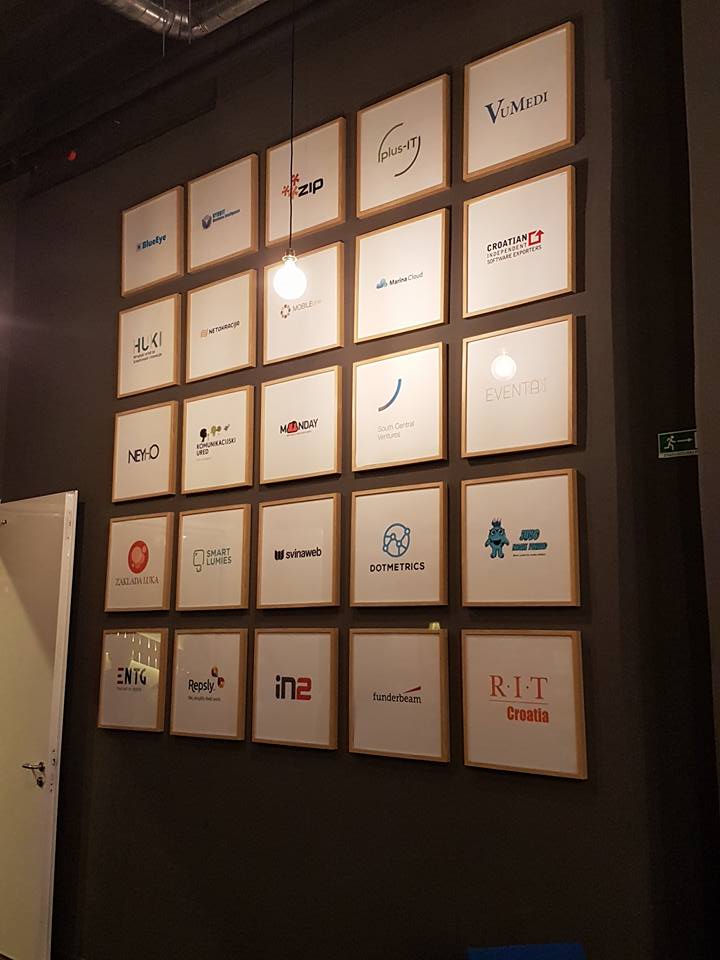
There was noticeable excitement among the young crowd as we waited to enter, and this was a sold-out event for sure. When organisers Mislav Javor and Alen Hrga announced the event to try and bring Zagreb’s blockchain developers together to chat, they were expecting about 30-40 replies. Within hours, they had had over 1,000. It made me smile when I heard that, for one of the great unsung positives about Croatia in general and Zagreb in particular, is the huge positive energy and innovation within its emerging IT sector. There may be no Silicon Valley tech giants with large offices in Zagreb, but there are some seriously gifted individuals doing great work and – a little like Croatia’s success in sport – here is a country punching above its relatively small weight on the international stage. The plaques on the HUB385 wall gave an indication of some of that energy. If I had not already been feeling my age and technical Neaderthalism, now I certainly was, but it was wonderful to see these young men (and a surprisingly large number of young woman), many of whom spend lonely hours with their computers in bedrooms at home. This conference was a great opportunity to network face to face with their peers, and they all seemed fully intent on taking advantage.
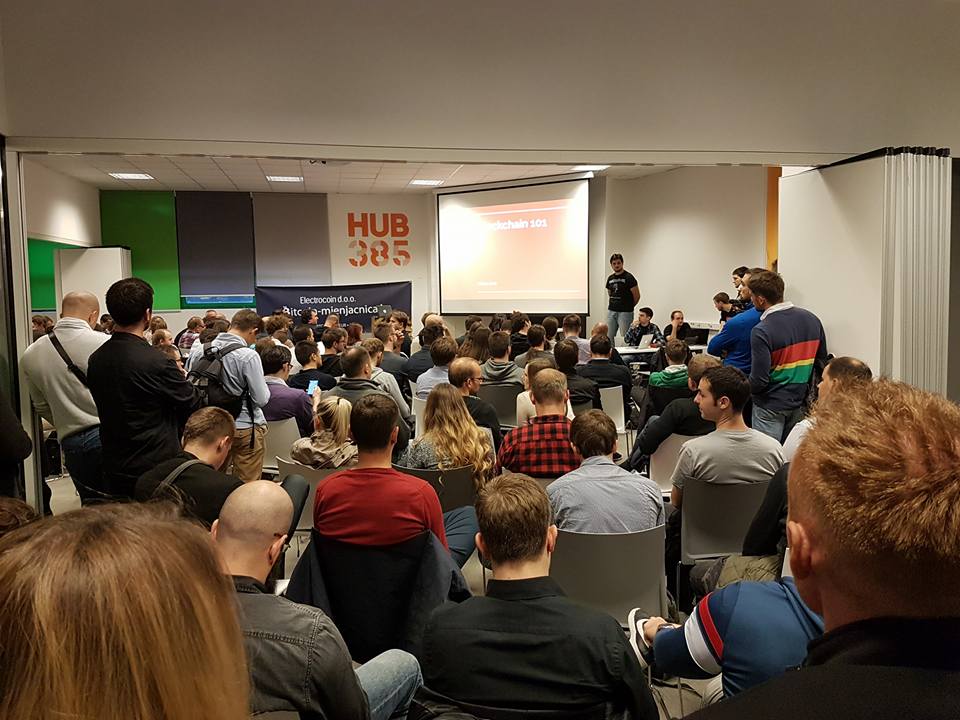
Totally full.
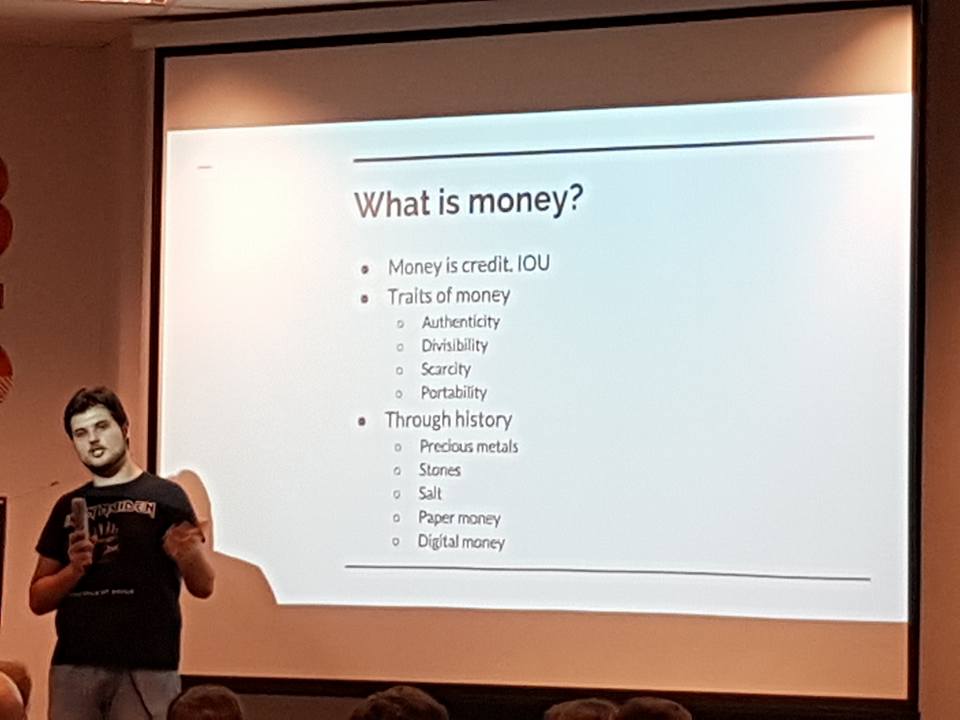
And so to the presentations, which began with an introduction to blockchains, trustless economy and smart contracts by organiser Mislav Javor, all new concepts to me, but familiar to everyone else in the room. The trustless economy was an interesting term. By putting everything on this public ledger which cannot be hacked or falsified, you eliminate the possibility of fraud. Take real estate for example. Currently ownership deeds are stored online and in courts, and while this might give one the sense of security in the UK or the States, documents are regularly falsified in other countries, so while you think you own the property, if an influential person in the ruling regime decides you do not, there is not a lot you can do about it. If all the real estate records were stored on the blockchain, however…
A more everyday possibility was explained to me in the pub after the event by my business partner’s team. They sell tickets online for events. Typically, credit card companies lost 5-7% of ticket sales through claims of fraud, where someone will buy the ticket by credit card, enjoy the concert and the ticket was bought fraudulently. Enter the trustless economy, where such transactions cannot be contested. There was definitely something to this blockchain concept, even this old dinosaur could see that.
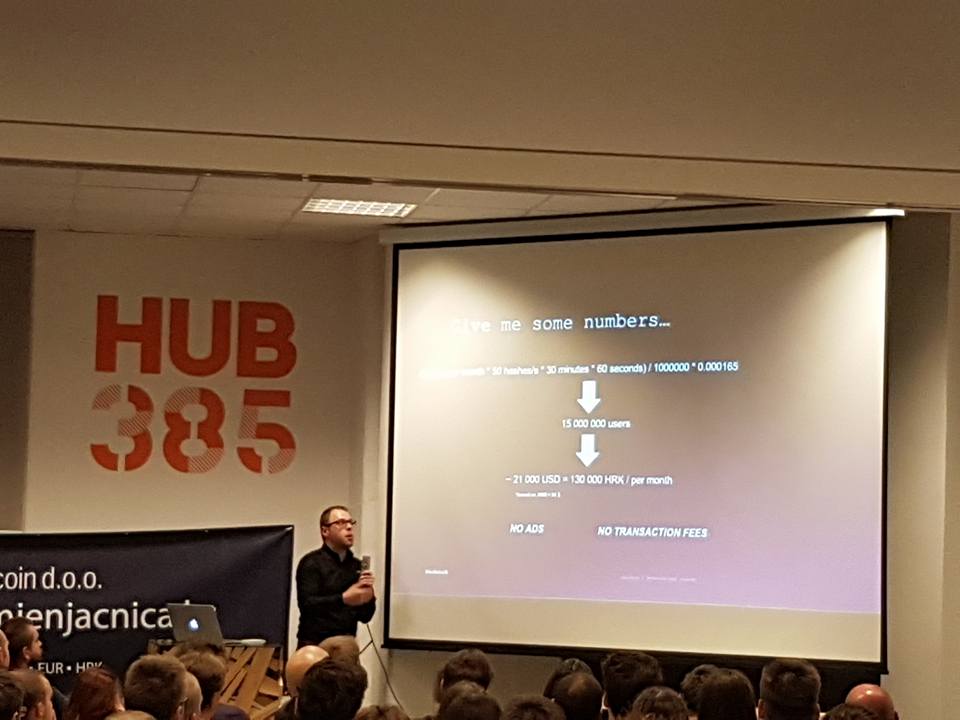
No sooner had the opening presentation finished than everyone had moved into small groups to discuss. There was free beer and pizza downstairs, and people took full advantage of the chance to talk and exchange ideas, before returning for Nilola Jokic’s Introduction to the ENS (Ethereum Name Service), .eth domains and Swarm decentralized storage. I won’t embarrass myself into giving you an in-depth analysis of this one, as I had not heard of either .eth domains or Swarm decentalized storage, but I was the only one in the room not on the same page.
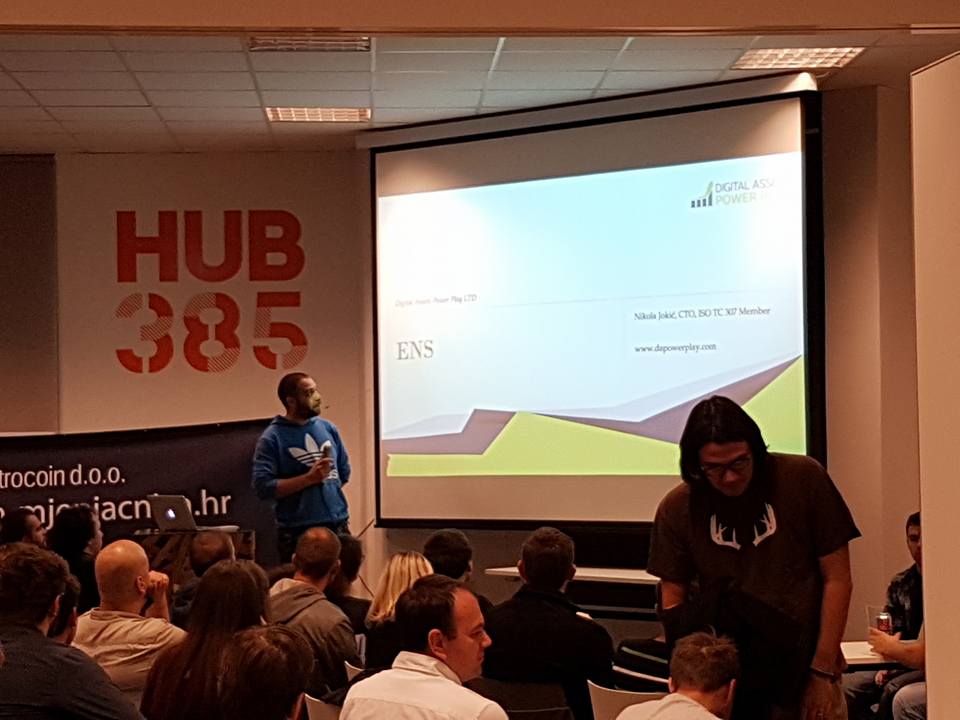
The final speaker confessed he had not slept in days, and as Marin Basic launched into Using the BlockStack API for developing location-based, P2P exchanges for cryptocurrencies and fiat money, he explained why – he was in the final 20 hours of fundraising and his company had so far raised $2.5 million for his blockchain projects.
There is something in this blockchain thing after all.
I emerged a little wiser, a lot more worried, and with more questions than answers, and I am grateful to all. My favourite part of the evening, however, was hanging out with my partner and his team, listening to them discuss the merits of Bitcoins, new concepts and application – true exchange of ideas and youthful energy.
“It felt a little like an Amway presentation I went to years ago,” I said.
“What is Amway?” they replied.
I smiled. Just as I have little idea of what is going on with the Millennial generation, so it seems, they increasingly can relate less and less to mine. Change is happening at such a frightening pace, that it will not be long before Millennials themselves will feel the pressure of change out of their control.
As for the blockchain, it has an air of permanence in these chaotic times, and anything that can save $40 billion dollars a year for the poorest people on the planet gets my vote. My brief introduction only touches the surface of the large work going on, and while the whole thing terrifies me, the unbounded enthusiasm and innovative ideas of this generation gave me heart.
As for me, time to learn how to be a Bitcoin miner, and see if I can join the last train of progress before it departs.










